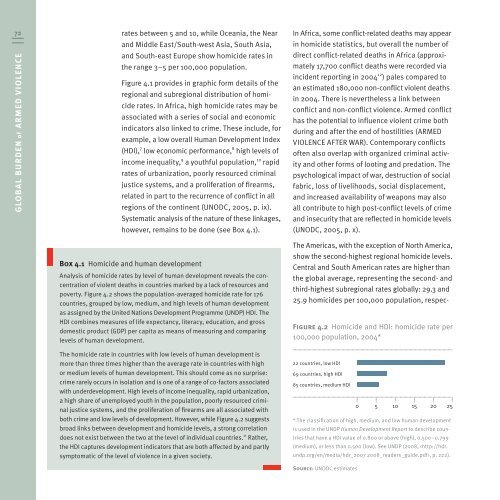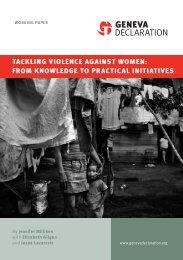Global Burden of Armed Violence - The Geneva Declaration on ...
Global Burden of Armed Violence - The Geneva Declaration on ...
Global Burden of Armed Violence - The Geneva Declaration on ...
Create successful ePaper yourself
Turn your PDF publications into a flip-book with our unique Google optimized e-Paper software.
72 rates between 5 and 10, while Oceania, the Near<br />
GLOBAL BURDEN <str<strong>on</strong>g>of</str<strong>on</strong>g> ARMED VIOLENCE<br />
and Middle East/South-west Asia, South Asia,<br />
and South-east Europe show homicide rates in<br />
the range 3–5 per 100,000 populati<strong>on</strong>.<br />
Figure 4.1 provides in graphic form details <str<strong>on</strong>g>of</str<strong>on</strong>g> the<br />
regi<strong>on</strong>al and subregi<strong>on</strong>al distributi<strong>on</strong> <str<strong>on</strong>g>of</str<strong>on</strong>g> homi-<br />
cide rates. In Africa, high homicide rates may be<br />
associated with a series <str<strong>on</strong>g>of</str<strong>on</strong>g> social and ec<strong>on</strong>omic<br />
indicators also linked to crime. <str<strong>on</strong>g>The</str<strong>on</strong>g>se include, for<br />
example, a low overall Human Development Index<br />
(HDI), 7 low ec<strong>on</strong>omic performance, 8 high levels <str<strong>on</strong>g>of</str<strong>on</strong>g><br />
income inequality, 9 a youthful populati<strong>on</strong>, 10 rapid<br />
rates <str<strong>on</strong>g>of</str<strong>on</strong>g> urbanizati<strong>on</strong>, poorly resourced criminal<br />
justice systems, and a proliferati<strong>on</strong> <str<strong>on</strong>g>of</str<strong>on</strong>g> firearms,<br />
related in part to the recurrence <str<strong>on</strong>g>of</str<strong>on</strong>g> c<strong>on</strong>flict in all<br />
regi<strong>on</strong>s <str<strong>on</strong>g>of</str<strong>on</strong>g> the c<strong>on</strong>tinent (UNODC, 2005, p. ix).<br />
Systematic analysis <str<strong>on</strong>g>of</str<strong>on</strong>g> the nature <str<strong>on</strong>g>of</str<strong>on</strong>g> these linkages,<br />
however, remains to be d<strong>on</strong>e (see Box 4.1).<br />
Box 4.1 Homicide and human development<br />
Analysis <str<strong>on</strong>g>of</str<strong>on</strong>g> homicide rates by level <str<strong>on</strong>g>of</str<strong>on</strong>g> human development reveals the c<strong>on</strong>centrati<strong>on</strong><br />
<str<strong>on</strong>g>of</str<strong>on</strong>g> violent deaths in countries marked by a lack <str<strong>on</strong>g>of</str<strong>on</strong>g> resources and<br />
poverty. Figure 4.2 shows the populati<strong>on</strong>-averaged homicide rate for 176<br />
countries, grouped by low, medium, and high levels <str<strong>on</strong>g>of</str<strong>on</strong>g> human development<br />
as assigned by the United Nati<strong>on</strong>s Development Programme (UNDP) HDI. <str<strong>on</strong>g>The</str<strong>on</strong>g><br />
HDI combines measures <str<strong>on</strong>g>of</str<strong>on</strong>g> life expectancy, literacy, educati<strong>on</strong>, and gross<br />
domestic product (GDP) per capita as means <str<strong>on</strong>g>of</str<strong>on</strong>g> measuring and comparing<br />
levels <str<strong>on</strong>g>of</str<strong>on</strong>g> human development.<br />
<str<strong>on</strong>g>The</str<strong>on</strong>g> homicide rate in countries with low levels <str<strong>on</strong>g>of</str<strong>on</strong>g> human development is<br />
more than three times higher than the average rate in countries with high<br />
or medium levels <str<strong>on</strong>g>of</str<strong>on</strong>g> human development. This should come as no surprise:<br />
crime rarely occurs in isolati<strong>on</strong> and is <strong>on</strong>e <str<strong>on</strong>g>of</str<strong>on</strong>g> a range <str<strong>on</strong>g>of</str<strong>on</strong>g> co-factors associated<br />
with underdevelopment. High levels <str<strong>on</strong>g>of</str<strong>on</strong>g> income inequality, rapid urbanizati<strong>on</strong>,<br />
a high share <str<strong>on</strong>g>of</str<strong>on</strong>g> unemployed youth in the populati<strong>on</strong>, poorly resourced criminal<br />
justice systems, and the proliferati<strong>on</strong> <str<strong>on</strong>g>of</str<strong>on</strong>g> firearms are all associated with<br />
both crime and low levels <str<strong>on</strong>g>of</str<strong>on</strong>g> development. However, while Figure 4.2 suggests<br />
broad links between development and homicide levels, a str<strong>on</strong>g correlati<strong>on</strong><br />
does not exist between the two at the level <str<strong>on</strong>g>of</str<strong>on</strong>g> individual countries. 11 Rather,<br />
the HDI captures development indicators that are both affected by and partly<br />
symptomatic <str<strong>on</strong>g>of</str<strong>on</strong>g> the level <str<strong>on</strong>g>of</str<strong>on</strong>g> violence in a given society.<br />
In Africa, some c<strong>on</strong>flict-related deaths may appear<br />
in homicide statistics, but overall the number <str<strong>on</strong>g>of</str<strong>on</strong>g><br />
direct c<strong>on</strong>flict-related deaths in Africa (approximately<br />
17,700 c<strong>on</strong>flict deaths were recorded via<br />
incident reporting in 2004 12 ) pales compared to<br />
an estimated 180,000 n<strong>on</strong>-c<strong>on</strong>flict violent deaths<br />
in 2004. <str<strong>on</strong>g>The</str<strong>on</strong>g>re is nevertheless a link between<br />
c<strong>on</strong>flict and n<strong>on</strong>-c<strong>on</strong>flict violence. <str<strong>on</strong>g>Armed</str<strong>on</strong>g> c<strong>on</strong>flict<br />
has the potential to influence violent crime both<br />
during and after the end <str<strong>on</strong>g>of</str<strong>on</strong>g> hostilities (ARMED<br />
VIOLENCE AFTER WAR). C<strong>on</strong>temporary c<strong>on</strong>flicts<br />
<str<strong>on</strong>g>of</str<strong>on</strong>g>ten also overlap with organized criminal activity<br />
and other forms <str<strong>on</strong>g>of</str<strong>on</strong>g> looting and predati<strong>on</strong>. <str<strong>on</strong>g>The</str<strong>on</strong>g><br />
psychological impact <str<strong>on</strong>g>of</str<strong>on</strong>g> war, destructi<strong>on</strong> <str<strong>on</strong>g>of</str<strong>on</strong>g> social<br />
fabric, loss <str<strong>on</strong>g>of</str<strong>on</strong>g> livelihoods, social displacement,<br />
and increased availability <str<strong>on</strong>g>of</str<strong>on</strong>g> weap<strong>on</strong>s may also<br />
all c<strong>on</strong>tribute to high post-c<strong>on</strong>flict levels <str<strong>on</strong>g>of</str<strong>on</strong>g> crime<br />
and insecurity that are reflected in homicide levels<br />
(UNODC, 2005, p. x).<br />
<str<strong>on</strong>g>The</str<strong>on</strong>g> Americas, with the excepti<strong>on</strong> <str<strong>on</strong>g>of</str<strong>on</strong>g> North America,<br />
show the sec<strong>on</strong>d-highest regi<strong>on</strong>al homicide levels.<br />
Central and South American rates are higher than<br />
the global average, representing the sec<strong>on</strong>d- and<br />
third-highest subregi<strong>on</strong>al rates globally: 29.3 and<br />
25.9 homicides per 100,000 populati<strong>on</strong>, respec-<br />
Figure 4.2 Homicide and HDI: homicide rate per<br />
100,000 populati<strong>on</strong>, 2004*<br />
22 countries, low HDI<br />
69 countries, high HDI<br />
85 countries, medium HDI<br />
0 5 10 15 20 25<br />
* <str<strong>on</strong>g>The</str<strong>on</strong>g> classificati<strong>on</strong> <str<strong>on</strong>g>of</str<strong>on</strong>g> high, medium, and low human development<br />
is used in the UNDP Human Development Report to describe coun-<br />
tries that have a HDI value <str<strong>on</strong>g>of</str<strong>on</strong>g> 0.800 or above (high), 0.500–0.799<br />
(medium), or less than 0.500 (low). See UNDP (2008, , p. 222).<br />
Source: UNODC estimates









